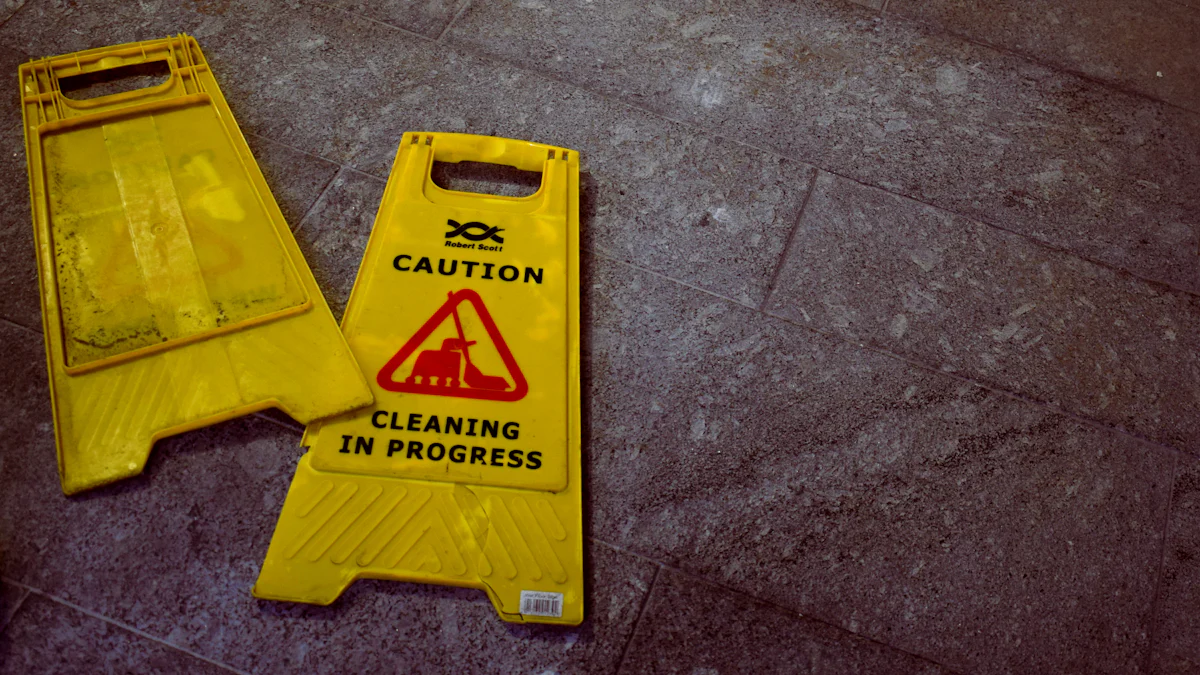
Imagine dealing with a sudden chemical spill at work. In moments like these, every second counts. That’s where a spill kit sign becomes your best ally. These signs clearly mark the location of spill kits, making it easy for you to find them during emergencies. They play a vital role in workplace safety by ensuring quick access to essential cleanup tools. Without them, confusion can delay your response, increasing the risk of accidents or environmental damage. A simple sign can make all the difference when time is critical.
Key Takeaways
Spill kit signs help you find spill kits fast in emergencies. This saves time and lowers dangers.
Good signs should be bright, strong, and simple to read. This helps everyone find and use spill kits easily.
Check and fix spill kit signs often to keep them clear and follow safety rules.
Add spill kit signs to your emergency plans. This helps people stay ready and know what to do during spills.
Teach workers how to use spill kit signs. Practice drills often to make spill response safer and build confidence.
Understanding Spill Kit Signs
What Are Spill Kit Signs?
You’ve probably seen signs around your workplace that point out fire extinguishers or first aid kits. Spill kit signs work the same way, but they specifically mark the location of spill kits. These kits contain tools and materials designed for spill control and cleanup. The signs make it easy to locate these kits during emergencies. Whether it’s a chemical spill or an oil leak, these signs guide you to the right resources for effective spill management.
Purpose of Spill Kit Signs
Why are these signs so important? Their main purpose is to ensure quick access to spill kits during emergencies. When a spill happens, every second counts. A clearly visible sign eliminates confusion and helps you act fast. These signs also support spill prevention by reminding everyone about the importance of proper spill control. They play a key role in emergency spill response, helping you minimize risks to safety, the environment, and workplace operations.
Key Features of Effective Spill Kit Signs
Not all signs are created equal. Effective spill kit signage should be easy to spot, even from a distance. Bright colors like yellow or red, combined with bold text, make them stand out. They should also include clear symbols or images to ensure everyone understands their purpose, even if they don’t speak the same language. Durability is another must-have feature. Signs should withstand harsh conditions, whether they’re placed indoors or outdoors. Finally, they need to comply with spill kit requirements and workplace safety standards.
Importance of Spill Kit Signs in Workplace Safety
Enhancing Emergency Preparedness
Emergencies don’t wait for you to be ready. When hazardous spills happen, you need to act fast. Spill kit signs help you stay prepared by clearly marking where spill kits are located. Imagine trying to find a spill kit in a chaotic situation without a sign to guide you. That delay could lead to bigger problems. With proper signage, you and your spill response team can quickly grab the tools you need to contain and clean up the spill. This simple step ensures your workplace is always ready to handle emergencies effectively.
Spill kit signs also support spill response plans. They make it easier for everyone to follow spill response procedures during a crisis. Whether it’s a chemical spill or an oil leak, these signs ensure you’re not wasting precious time searching for the right equipment.
Preventing Workplace Hazards
Spill kit signs do more than just point out where spill kits are. They play a big role in spill prevention. When employees see these signs, they’re reminded of the importance of spill control and proper handling of materials. This awareness can reduce the chances of spills happening in the first place.
In case of a spill, the signs guide you to the tools needed for containment. Quick action can prevent hazardous spills from spreading and causing harm to people, property, or the environment. By using spill kits promptly, you can minimize risks and keep your workplace safe.
Ensuring Compliance with Spill Kit Requirements
Workplace safety regulations often include specific spill kit requirements. Having clear, visible spill kit signs helps you meet these compliance standards. Regulatory bodies expect businesses to have proper spill management systems in place, and signage is a key part of that.
Failing to comply with these requirements can lead to fines or other penalties. But more importantly, it puts your team’s safety at risk. By ensuring your spill kit signs are up to standard, you’re not just meeting compliance rules—you’re creating a safer work environment for everyone.
Tip: Regularly check your spill kit signs to ensure they’re visible and in good condition. This small effort can make a big difference in both safety and compliance.
Types of Spill Kit Signs and Their Applications

Location-Based Spill Kit Signs
When an emergency strikes, knowing exactly where to find spill kits can save valuable time. Location-based spill kit signs make this possible by clearly marking where these essential tools are stored. These signs often use bright colors like red or yellow to stand out, ensuring they’re easy to spot even in busy or cluttered areas. Large wall or floor signs act as constant reminders of spill kit locations, while smaller signs can guide you to kits stored in less obvious places, like under workbenches. This type of signage improves accessibility and ensures your spill response team can act quickly when hazardous spills occur.
Instructional Spill Kit Signs
Sometimes, knowing where the spill kit is isn’t enough—you also need to know how to use it. That’s where instructional spill kit signs come in. These signs provide step-by-step guidance on using spill kits effectively. They might include instructions for spill containment, spill control, or proper disposal of hazardous materials. Clear visuals and simple language make these signs easy to understand, even in high-pressure situations. By following the instructions, you can ensure that spill response procedures are carried out correctly, minimizing risks and maintaining workplace safety.
Hazard-Specific Spill Kit Signs
Not all spills are the same, and neither are all spill kits. Hazard-specific spill kit signs help you identify the right kit for the job. For example, marine spill kits are designed for spills in aquatic environments, while chemical spill kits are tailored for hazardous chemical leaks. These signs often include symbols or labels indicating the type of spill the kit is meant for. This ensures you’re using the correct tools for effective spill management and compliance with spill kit requirements.
Pro Tip: Regularly check your spill kit signage to ensure it’s visible and matches the type of spills your workplace might encounter.
Placement and Maintenance of Spill Kit Signs

Strategic Placement for Maximum Visibility
Where you place your spill kit signs can make or break your emergency response. You want these signs to be in spots where they’re impossible to miss. High-risk areas like loading docks, chemical storage rooms, and maintenance shops are prime locations. These are places where hazardous spills are more likely to occur.
Make sure the signs are bright and easy to spot, even in a crowded or busy environment. Floor markings or wall-mounted signs work well for this. But don’t place spill kits too close to potential spill sites. You don’t want them to become part of the problem during an emergency. Instead, keep them nearby but in a safe, accessible spot. Regularly review the placement of your spill kits and signs with your team. This helps you adapt to any changes in your workplace or new hazards that might pop up.
Regular Maintenance and Inspection
Spill kit signs need to stay in top condition to do their job. Over time, wear and tear can make them less effective. That’s why regular inspections are a must. Check your signs every one to six months to ensure they’re still visible and intact. If you notice fading, damage, or anything that makes them hard to read, replace them immediately.
While you’re at it, inspect the spill kits themselves. Sealed kits can usually be checked visually, but unsealed ones might need a closer look. Make sure all the spill control equipment is in good shape and ready to use. A quick inspection can save you from bigger problems down the line.
Integrating Spill Kit Signs with Emergency Plans
Your spill kit signs shouldn’t just exist in isolation. They need to be part of your overall emergency plans. Train your spill response team to use these signs as part of their spill response procedures. During drills, practice locating and using spill kits based on the signage. This ensures everyone knows what to do when it matters most.
Clear signage also supports compliance with spill kit requirements. Regulatory bodies expect you to have a solid spill management system in place, and proper signage is a big part of that. By integrating your signs into your emergency plans, you’re not just meeting compliance standards—you’re creating a safer workplace for everyone.
Tip: Keep your spill kit signs updated as your workplace evolves. This small step can make a huge difference in both safety and spill prevention.
Best Practices for Implementing Spill Kit Signs
Conducting a Workplace Safety Assessment
Before you can effectively implement spill kit signs, you need to assess your workplace. This step helps you identify where hazardous spills are most likely to occur and ensures your spill kits are easy to locate. Start by checking that spill kits are stored in visible areas. Brightly colored containers or large wall signs can make them stand out. Label each container clearly, detailing the type of kit and its contents.
Don’t stop there. Train your team on the location and use of spill control equipment. Practice drills and refresher training sessions can help reinforce this knowledge. Also, inspect your spill kits regularly. Make sure all tools are in good condition and ready for use. These steps not only improve safety but also ensure compliance with spill kit requirements.
Training Employees on Spill Kit Sign Usage
Training your emergency spill response team is crucial for effective spill management. You can use several methods to teach employees about spill kit signs and their purpose. On-site training programs are great for hands-on learning. They allow your team to practice using spill kits in real-life scenarios. Online courses offer flexibility, letting employees learn at their own pace through videos and quizzes.
You can also take advantage of vendor-led training programs. Many suppliers provide free or discounted sessions focused on their products. Local OSHA or EPA workshops are another excellent resource. These programs align with regulatory standards and provide credible guidance. During training, cover key topics like isolating spills, containment strategies, and proper cleanup procedures. Regular drills and refresher courses ensure your team stays prepared for emergencies.
Periodically Reviewing and Updating Spill Kit Signage
Workplaces change over time, and your spill kit signage should evolve with it. Periodically review your signs to ensure they’re still relevant and effective. Check for any fading, damage, or changes in workplace layout that might affect visibility. Replace outdated signs immediately to avoid confusion during emergencies.
Updating your signage isn’t just about maintenance. It’s also an opportunity to improve your spill response system. For example, if you’ve added a new chemical spill kit, make sure the signage reflects this change. Regular updates help you stay compliant with spill kit training guidelines and workplace safety standards. They also ensure your team has the tools they need to clean up spills quickly and efficiently.
Pro Tip: Schedule a quarterly review of your spill kit signs and equipment. This small effort can make a big difference in preventing hazardous spills and ensuring compliance.
Spill kit signs play a vital role in keeping your workplace safe and prepared. They help you respond quickly to spills, reducing risks and preventing accidents. By using these signs, you also ensure compliance with safety regulations, avoiding potential fines or legal issues.
Prioritizing proper implementation and maintenance of spill kit signs offers long-term benefits. You’ll see faster response times, lower cleanup costs, and fewer disruptions to your workflow. Employees gain confidence and become better at spotting risks before they escalate. Over time, this investment creates a safer, more efficient workplace.
Make spill kit signs a priority today. A small step now can lead to big safety improvements for your team and operations.
FAQ
What is the best way to ensure spill kit signs are visible?
Place them in high-traffic or high-risk areas like chemical storage rooms or loading docks. Use bright colors and bold text to make them stand out. Regularly inspect the signs to ensure they remain visible and undamaged.
Tip: Use reflective materials for signs in dimly lit areas.
How often should spill kit signs be inspected?
Inspect your spill kit signs every 1-6 months. Look for fading, damage, or anything that reduces visibility. Replace worn-out signs immediately to maintain their effectiveness during emergencies.
Can spill kit signs help with regulatory compliance?
Yes! Clear and visible spill kit signs are often required by workplace safety regulations. They demonstrate your commitment to safety and help you avoid fines or penalties.
What should I do if my workplace changes layout?
Update your spill kit signage immediately. Relocate signs to match the new layout and ensure they remain easy to spot. This keeps your emergency response system effective and compliant.
Do employees need training to use spill kit signs?
Absolutely! Train your team to recognize and follow spill kit signs during emergencies. Practice drills help reinforce this knowledge and ensure everyone knows how to respond quickly and effectively.
Pro Tip: Combine sign training with hands-on spill kit usage for better preparedness.
See Also
Selecting Ideal Universal Absorbent Socks for Your Work Environment
Evaluating UPQUARK Marine Absorbents for Oil Spill Response

